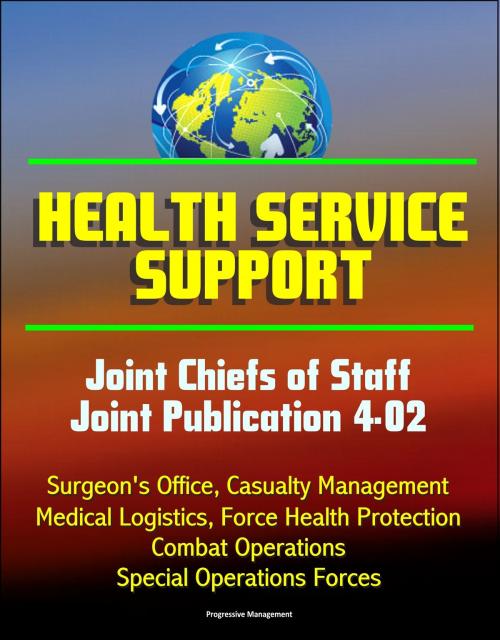Health Service Support: Joint Chiefs of Staff Joint Publication 4-02 - Surgeon's Office, Casualty Management, Medical Logistics, Force Health Protection, Combat Operations, Special Operations Forces
Nonfiction, History, Military| Author: | Progressive Management | ISBN: | 9781311184566 |
| Publisher: | Progressive Management | Publication: | January 11, 2015 |
| Imprint: | Smashwords Edition | Language: | English |
| Author: | Progressive Management |
| ISBN: | 9781311184566 |
| Publisher: | Progressive Management |
| Publication: | January 11, 2015 |
| Imprint: | Smashwords Edition |
| Language: | English |
This publication provides doctrine for the planning, preparation, and execution of health service support across the range of military operations.
The Military Health System supports the operational mission by fostering, protecting, sustaining, and restoring health. It also provides the direction, resources, health care providers, and other means necessary for promoting the health of the beneficiary population. Principles of Health Service Support - The principles of health service support (HSS) consist of conformity, proximity, flexibility, mobility, continuity, and control. Conformity - Conformity with the tactical plan is the most basic element for effectively providing health support. Medical planners must be involved early in the planning process, and once the plan is established, it must be rehearsed with the forces it supports. Proximity - The principle of proximity is to provide health support to sick, injured, and wounded military personnel at the right time and to keep morbidity and mortality to a minimum. Flexibility - Flexibility is being prepared and empowered to shift medical resources to meet changing requirements. The medical commander must build flexibility into the operation plan (OPLAN) to support the combatant commander's (CCDR's) scheme of maneuver. Mobility - The principle of mobility is to ensure that medical assets remain within supporting distance of maneuvering forces. Continuity - Continuity of care and treatment is achieved by moving the patient through progressive, phased roles of care, extending from the point of injury or wounding to the US-support base. Each type of medical unit contributes a measured, logical increment of care appropriate to its location and capabilities.
CHAPTER I * HEALTH SUPPORT TO JOINT OPERATIONS OVERVIEW * • Introduction * Military Health System * Principles of Health Service Support * Joint Medical Capabilities * CHAPTER II * ROLES AND RESPONSIBILITIES * Command and Control * Joint Force Surgeon's Office * Organizing the Joint Force Surgeon's Office * Joint Force Surgeon's Office Battle Rhythm * Staff Organizations * Joint Force Surgeon Reachback * CHAPTER III * HEALTH SERVICE SUPPORT * Casualty Management * Patient Movement * Medical Logistics * Health Information Management * CHAPTER IV * FORCE HEALTH PROTECTION * Casualty Prevention * Preventive Medicine * Health Surveillance * Combat and Operational Stress Control * Preventive Dentistry * Vision Readiness * Laboratory Services * Veterinary Services * CHAPTER V * HEALTH SERVICE SUPPORT OPERATIONS * Combat Operations * Stability and Civil-Military Operations * Limited Contingencies and Crisis Response * Defense Support of Civil Authorities * Special Operations Forces * Multinational Operations * Detainee Operations * Operations in a Chemical, Biological, Radiological, and Nuclear Environment * Contractor Support * CHAPTER VI * JOINT HEALTH PLANNING * Introduction * Health Support Planning Considerations * Planning Joint Medical Logistics * Systems and Planning Tools * APPENDIX * A - Hospitalization * B - Patient Movement * C - Service Component Transportation Assets * D - Medical Logistics Support * E - Blood Management * F - Intelligence Support to Joint Health Support * G - Casualty Prevention * H Patient Area Reception * J - Medical Aspects of Reintegration * K - Impacts of the Law of War and Medical Ethics * L - Planning Checklists * M - References * N - Administrative Instructions
This publication provides doctrine for the planning, preparation, and execution of health service support across the range of military operations.
The Military Health System supports the operational mission by fostering, protecting, sustaining, and restoring health. It also provides the direction, resources, health care providers, and other means necessary for promoting the health of the beneficiary population. Principles of Health Service Support - The principles of health service support (HSS) consist of conformity, proximity, flexibility, mobility, continuity, and control. Conformity - Conformity with the tactical plan is the most basic element for effectively providing health support. Medical planners must be involved early in the planning process, and once the plan is established, it must be rehearsed with the forces it supports. Proximity - The principle of proximity is to provide health support to sick, injured, and wounded military personnel at the right time and to keep morbidity and mortality to a minimum. Flexibility - Flexibility is being prepared and empowered to shift medical resources to meet changing requirements. The medical commander must build flexibility into the operation plan (OPLAN) to support the combatant commander's (CCDR's) scheme of maneuver. Mobility - The principle of mobility is to ensure that medical assets remain within supporting distance of maneuvering forces. Continuity - Continuity of care and treatment is achieved by moving the patient through progressive, phased roles of care, extending from the point of injury or wounding to the US-support base. Each type of medical unit contributes a measured, logical increment of care appropriate to its location and capabilities.
CHAPTER I * HEALTH SUPPORT TO JOINT OPERATIONS OVERVIEW * • Introduction * Military Health System * Principles of Health Service Support * Joint Medical Capabilities * CHAPTER II * ROLES AND RESPONSIBILITIES * Command and Control * Joint Force Surgeon's Office * Organizing the Joint Force Surgeon's Office * Joint Force Surgeon's Office Battle Rhythm * Staff Organizations * Joint Force Surgeon Reachback * CHAPTER III * HEALTH SERVICE SUPPORT * Casualty Management * Patient Movement * Medical Logistics * Health Information Management * CHAPTER IV * FORCE HEALTH PROTECTION * Casualty Prevention * Preventive Medicine * Health Surveillance * Combat and Operational Stress Control * Preventive Dentistry * Vision Readiness * Laboratory Services * Veterinary Services * CHAPTER V * HEALTH SERVICE SUPPORT OPERATIONS * Combat Operations * Stability and Civil-Military Operations * Limited Contingencies and Crisis Response * Defense Support of Civil Authorities * Special Operations Forces * Multinational Operations * Detainee Operations * Operations in a Chemical, Biological, Radiological, and Nuclear Environment * Contractor Support * CHAPTER VI * JOINT HEALTH PLANNING * Introduction * Health Support Planning Considerations * Planning Joint Medical Logistics * Systems and Planning Tools * APPENDIX * A - Hospitalization * B - Patient Movement * C - Service Component Transportation Assets * D - Medical Logistics Support * E - Blood Management * F - Intelligence Support to Joint Health Support * G - Casualty Prevention * H Patient Area Reception * J - Medical Aspects of Reintegration * K - Impacts of the Law of War and Medical Ethics * L - Planning Checklists * M - References * N - Administrative Instructions















